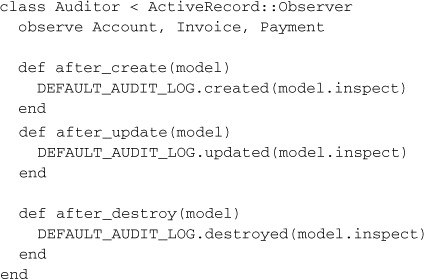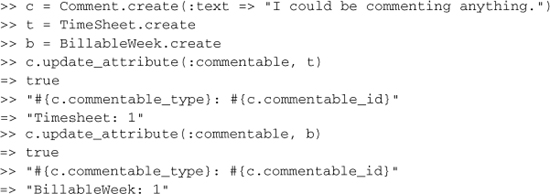Chapter 9. Advanced Active Record
Active Record is a simple object-relational mapping (ORM) framework compared to other popular ORM frameworks, such as Hibernate in the Java world. Don’t let that fool you, though: Under its modest exterior, Active Record has some pretty advanced features. To really get the most effectiveness out of Rails development, you need to have more than a basic understanding of Active Record—things like knowing when to break out of the one-table/one-class pattern, or how to leverage Ruby modules to keep your code clean and free of duplication.
In this chapter, we wrap up this book’s comprehensive coverage of Active Record by reviewing callbacks, observers, single-table inheritance (STI), and polymorphic models. We also review a little bit of information about metaprogramming and Ruby domain-specific languages (DSLs) as they relate to Active Record.
9.1 Scopes
Scopes (or “named scopes” if you’re old school) allow you define and chain query criteria in a declarative and reusable manner.

To declare a scope, use the scope class method, passing it a name as a symbol and some sort of query definition. If your query is known at load time, you can simply use Arel criteria methods like where, order, and limit to construct the definition as shown in the example. On the other hand, if you won’t have all the parameters for your query until runtime, use a lambda as the second parameter. It will get evaluated whenever the scope is invoked.

Invoke scopes as you would class methods.
![]()
9.1.1 Scope Parameters
You can pass arguments to scope invocations by adding parameters to the lambda you use to define the scope query.
![]()
Then pass the argument to the scope as you would normally.
BillableWeek.newer_than(Date.today)
9.1.2 Chaining Scopes
One of the beauties of scopes is that you can chain them together to create complex queries from simple ones:
![]()
Scopes can be chained together for reuse within scope definitions themselves. For instance, let’s say that we always want to constrain the result set of underutilized to submitted timesheets:

9.1.3 Scopes and has_many
In addition to being available at the class context, scopes are available automatically on has_many association attributes.
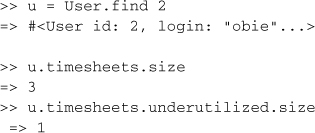
9.1.4 Scopes and Joins
You can use Arel’s join method to create cross-model scopes. For instance, if we gave our recurring example Timesheet a submitted_at date attribute instead of just a boolean, we could add a scope to User allowing us to see who is late on their timesheet submission.

Arel’s to_sql method is useful for debugging scope definitions and usage.

Note that as demonstrated in the example, it’s a good idea to use unambiguous column references (including table name) in cross-model scope definitions so that Arel doesn’t get confused.
9.1.5 Scope Combinations
Our example of a cross-model scope violates good object-oriented design principles: it contains the logic for determining whether or not a Timesheet is submitted, which is code that properly belongs in the Timesheet class. Luckily we can use Arel’s merge method (aliased as &) to fix it. First we put the late logic where it belongs, in Timesheet:
scope :late, lambda { where("timesheet.submitted_at <= ?", 7.days.ago) }
Then we use our new late scope in tardy:

If you have trouble with this technique, make absolutely sure that your scopes’ clauses refer to fully qualified column names. (In other words, don’t forget to prefix column names with tables.) The console and to_sql method is your friend for debugging.
9.1.6 Default Scopes
There may arise use cases where you want certain conditions applied to the finders for your model. Consider our timesheet application has a default view of open timesheets—we can use a default scope to simplify our general queries.

Now when we query for our Timesheets, by default the open condition will be applied:
![]()
Default scopes also get applied to your models when building or creating them, which can be a great convenience or a nuisance if you are not careful. In our previous example, all new Timesheets will be created with a status of “open.”

You can override this behavior by providing your own conditions or scope to override the default setting of the attributes.

There may be cases where at runtime you want to create a scope and pass it around as a first class object leveraging your default scope. In this case, Active Record provides the scoped method.

There’s another approach to scopes that provides a sleeker syntax, scoping, which allows the chaining of scopes via nesting within a block.

That’s pretty nice, but what if we don’t want our default scope to be included in our queries? In this case Active Record takes care of us through the unscoped method.
![]()
Similarly to overriding our default scope with a relation when creating new objects, we can supply unscoped as well to remove the default attributes.
![]()
9.1.7 Using Scopes for CRUD
You have a wide range of Active Record’s CRUD methods available on scopes, which gives you some powerful abilities. For instance, let’s give all our underutilized timesheets some extra hours.

Scopes including a where clause using hashed conditions will populate attributes of objects built off of them with those attributes as default values. Admittedly it’s a bit difficult to think of a plausible use case for this feature, but we’ll show it in an example. First, we add the following scope to Timesheet:
scope :perfect, submitted.where(:total_hours => 40)
Now, building an object on the perfect scope should give us a submitted timesheet with 40 hours.
![]()
As you’ve probably realized by now, the new Arel underpinnings of Active Record are tremendously powerful and truly elevate the Rails 3 platform.
9.2 Callbacks
This advanced feature of Active Record allows the savvy developer to attach behavior at a variety of different points along a model’s life cycle, such as after initialization, before database records are inserted, updated or removed, and so on.
Callbacks can do a variety of tasks, ranging from simple things such as logging and massaging of attribute values prior to validation, to complex calculations. Callbacks can halt the execution of the life-cycle process taking place. Some callbacks can even modify the behavior of the model class on the fly. We’ll cover all of those scenarios in this section, but first let’s get a taste of what a callback looks like. Check out the following silly example:

So prior to dying (ehrm, being destroy’d), the last words of the Beethoven class will always be logged for posterity. As we’ll see soon, there are 14 different opportunities to add behavior to your model in this fashion. Before we get to that list, let’s cover the mechanics of registering a callback.
9.2.1 Callback Registration
Overall, the most common way to register a callback method is to declare it at the top of the class using a typical Rails macro-style class method. However, there’s a less verbose way to do it also. Simply implement the callback as a method in your class. In other words, I could have coded the prior example as follows:

This is a rare case of the less-verbose solution being bad. In fact, it is almost always preferable, dare I say it is the Rails way, to use the callback macros over implementing callback methods, for the following reasons:
• Macro-style callback declarations are added near the top of the class definition, making the existence of that callback more evident versus a method body potentially buried later in the file.
• Macro-style callbacks add callback methods to a queue. That means that more than one method can be hooked into the same slot in the life cycle. Callbacks will be invoked in the order in which they were added to the queue.
• Callback methods for the same hook can be added to their queue at different levels of an inheritance hierarchy and still work—they won’t override each other the way that methods would.
• Callbacks defined as methods on the model are always called last.
9.2.2 One-Liners
Now, if (and only if) your callback routine is really short,1 you can add it by passing a block to the callback macro. We’re talking one-liners!

As of Rails 3, the block passed to a callback is executed via instance_eval so that its scope is the record itself (versus needing to act on a passed in record variable). The following example implements “paranoid” model behavior, covered later in the chapter.
![]()
9.2.3 Protected or Private
Except when you’re using a block, the access level for callback methods should always be protected or private. It should never be public, since callbacks should never be called from code outside the model.
Believe it or not, there are even more ways to implement callbacks, but we’ll cover those techniques further along in the chapter. For now, let’s look at the lists of callback hooks available.
9.2.4 Matched before/after Callbacks
In total, there are 14 types of callbacks you can register on your models! Twelve of them are matching before/after callback pairs, such as before_validation and after_validation. (The other two, after_initialize and after_find, are special, and we’ll discuss them later in this section.)
List of Callbacks
This is the list of callback hooks available during a save operation. (The list varies slightly depending on whether you’re saving a new or existing record.)
• before_validation
• before_validation_on_create
• after_validation
• after_validation_on_create
• before_save
• before_create (for new records) and before_update (for existing records)
• (Database actually gets an INSERT or UPDATE statement here)
• after_create (for new records) and after_update (for existing records)
• after_save
Delete operations have their own two callbacks:
• before_destroy
• (Database actually gets a DELETE statement here)
• after_destroy is called after all attributes have been frozen (read-only)
Additionally transactions have callbacks as well, for when you want actions to occur after the database is guaranteed to be in a permanent state. Note that only “after” callbacks exist here because of the nature of transactions—it’s a bad idea to be able to interfere with the actual operation itself.
• after_commit_on_create
• after_commit_on_update
• after_commit_on_destroy
• after_rollback
• after_rollback_on_create
• after_rollback_on_update
• after_rollback_on_destroy
9.2.5 Halting Execution
If you return a boolean false (not nil) from a callback method, Active Record halts the execution chain. No further callbacks are executed. The save method will return false, and save! will raise a RecordNotSaved error.
Keep in mind that because the last expression of a Ruby method is returned implicitly, it is a pretty common bug to write a callback that halts execution unintentionally. If you have an object with callbacks that mysteriously fails to save, make sure you aren’t returning false by mistake.
9.2.6 Callback Usages
Of course, the callback you should use for a given situation depends on what you’re trying to accomplish. The best I can do is to serve up some examples to inspire you with your own code.
Cleaning Up Attribute Formatting with before_validate_on_create
The most common examples of using before_validation callbacks have to do with cleaning up user-entered attributes. For example, the following CreditCard class cleans up its number attribute so that false negatives don’t occur on validation:
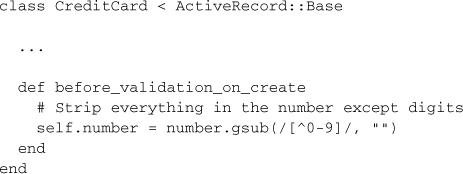
Geocoding with before_save
Assume that you have an application that tracks addresses and has mapping features. Addresses should always be geocoded before saving, so that they can be displayed rapidly on a map later.2
As is often the case, the wording of the requirement itself points you in the direction of the before_save callback:
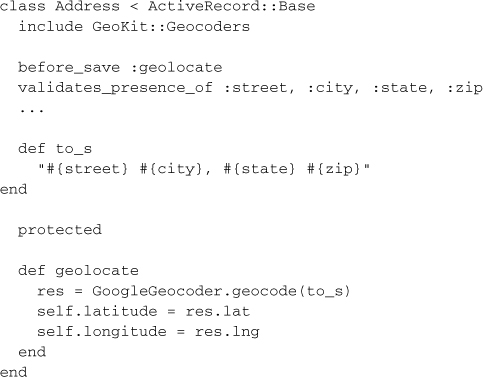
Before we move on, there are a couple of additional considerations. The preceding code works great if the geocoding succeeds, but what if it doesn’t? Do we still want to allow the record to be saved? If not, we should halt the execution chain:

The only problem remaining is that we give the rest of our code (and by extension, the end user) no indication of why the chain was halted. Even though we’re not in a validation routine, I think we can put the errors collection to good use here:
![]()
If the geocoding fails, we add a base error message (for the whole object) and halt execution, so that the record is not saved.
Exercise Your Paranoia with before_destroy
What if your application has to handle important kinds of data that, once entered, should never be deleted? Perhaps it would make sense to hook into Active Record’s destroy mechanism and somehow mark the record as deleted instead?
The following example depends on the accounts table having a deleted_at datetime column.

I chose to implement it as a callback method so that I am guaranteed it will execute last in the before_destroy queue. It returns false so that execution is halted and the underlying record is not actually deleted from the database.3
It’s probably worth mentioning that there are ways that Rails allows you to unintentionally circumvent before_destroy callbacks:
• The delete and delete_all class methods of ActiveRecord::Base are almost identical. They remove rows directly from the database without instantiating the corresponding model instances, which means no callbacks will occur.
• Model objects in associations defined with the option :dependent => :delete_all will be deleted directly from the database when removed from the collection using the association’s clear or delete methods.
Cleaning Up Associated Files with after_destroy
Model objects that have files associated with them, such as attachment records and uploaded images, can clean up after themselves when deleted using the after_destroy callback. The following method from Rick Olson’s old AttachmentFu4 plugin is a good example:

9.2.7 Special Callbacks: after_initialize and after_find
The after_initialize callback is invoked whenever a new Active Record model is instantiated (either from scratch or from the database). Having it available prevents you from having to muck around with overriding the actual initialize method.
The after_find callback is invoked whenever Active Record loads a model object from the database, and is actually called before after_initialize, if both are implemented. Because after_find and after_initialize are called for each object found and instantiated by finders, performance constraints dictate that they can only be added as methods, and not via the callback macros.
What if you want to run some code only the first time that a model is ever instantiated, and not after each database load? There is no native callback for that scenario, but you can do it using the after_initialize callback. Just add a condition that checks to see if it is a new record:

In a number of Rails apps that I’ve written, I’ve found it useful to capture user preferences in a serialized hash associated with the User object. The serialize feature of Active Record models makes this possible, since it transparently persists Ruby object graphs to a text column in the database. Unfortunately, you can’t pass it a default value, so I have to set one myself:
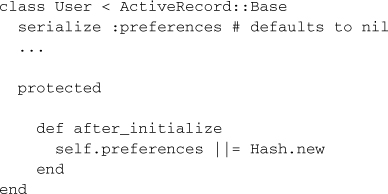
Using the after_initialize callback, I can automatically populate the preferences attribute of my user model with an empty hash, so that I never have to worry about it being nil when I access it with code such as user.preferences[:show_help_text] = false.
Ruby’s metaprogramming capabilities combined with the ability to run code whenever a model is loaded using the after_find callback are a powerful mix. Since we’re not done learning about callbacks yet, we’ll come back to uses of after_find later on in the chapter, in the section “Modifying Active Record Classes at Runtime.”
9.2.8 Callback Classes
It is common enough to want to reuse callback code for more than one object that Rails gives you a way to write callback classes. All you have to do is pass a given callback queue an object that responds to the name of the callback and takes the model object as a parameter.
Here’s our paranoid example from the previous section as a callback class:

The behavior of MarkDeleted is stateless, so I added the callback as a class method. Now you don’t have to instantiate MarkDeleted objects for no good reason. All you do is pass the class to the callback queue for whichever models you want to have the mark-deleted behavior:

Multiple Callback Methods in One Class
There’s no rule that says you can’t have more than one callback method in a callback class. For example, you might have special audit log requirements to implement:

To add audit logging to an Active Record class, you would do the following:

Wow, that’s ugly, having to add three Auditors on three lines. We could extract a local variable called auditor, but it would still be repetitive. This might be an opportunity to take advantage of Ruby’s open classes, the fact that you can modify classes that aren’t part of your application.
Wouldn’t it be better to simply say acts_as_audited at the top of the model that needs auditing? We can quickly add it to the ActiveRecord::Base class, so that it’s available for all our models.
On my projects, the file where “quick and dirty” code like the method in Listing 9.1 would reside is lib/core_ext/active_record_base.rb, but you can put it anywhere you want. You could even make it a plugin (as detailed in Chapter 19, “Extending Rails with Plugins”).
Listing 9.1. A quick-and-dirty ‘‘acts as audited’’ method
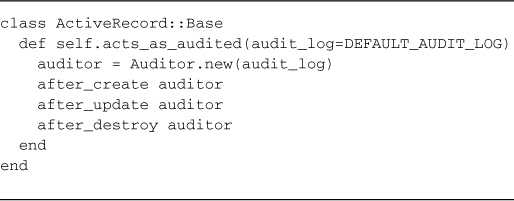
Now, the top of Account is a lot less cluttered:
class Account < ActiveRecord::Base
acts_as_audited
Testability
When you add callback methods to a model class, you pretty much have to test that they’re functioning correctly in conjunction with the model to which they are added. That may or may not be a problem. In contrast, callback classes are super-easy to test in isolation.

9.3 Calculation Methods
All Active Record classes have a calculate method that provides easy access to aggregate function queries in the database. Methods for count, sum, average, minimum, and maximum have been added as convenient shortcuts.
Options such as conditions, :order, :group, :having, and :joins can be passed to customize the query.
There are two basic forms of output:
Single aggregate valueThe single value is type cast to Fixnum for COUNT, Float for AVG, and the given column’s type for everything else.
Grouped valuesThis returns an ordered hash of the values and groups them by the :group option. It takes either a column name, or the name of a belongs_to association.
The following options are available to all calculation methods:
:conditionsAn SQL fragment like "administrator = 1" or [ "user_name = ?", username ]. See conditions in the intro to ActiveRecord::Base.
:includeEager loading, see Associations for details. Since calculations don’t load anything, the purpose of this is to access fields on joined tables in your conditions, order, or group clauses.
:joinsAn SQL fragment for additional joins like "LEFT JOIN comments ON comments.post_id = id". (Rarely needed). The records will be returned read-only since they will have attributes that do not correspond to the table’s columns.
:orderAn SQL fragment like "created_at DESC, name" (really only used with GROUP BY calculations).
:groupAn attribute name by which the result should be grouped. Uses the GROUP BY SQL-clause.
:selectBy default, this is * as in SELECT * FROM, but can be changed if you, for example, want to do a join, but not include the joined columns.
:distinctSet this to true to make this a distinct calculation, such as SELECT COUNT(DISTINCT posts.id) ...
The following examples illustrate the usage of various calculation methods.
9.3.1 average(column_name, *options)
Calculates the average value on a given column. The first parameter should be a symbol identifying the column to be averaged.
9.3.2 count(column_name, *options)
Count operates using three different approaches. Count without parameters will return a count of all the rows for the model. Count with a column_name will return a count of all the rows for the model with the supplied colum present. Lastly, count using :options will find the row count matched by the options used. In the last case you would send an options hash as the only parameter. 213
total_contacts = person.contacts.count(:from => "contact_cards")
Options are the same as with all other calculations methods with the additional option of :from which is by default the name of the table name of the class, however it can be changed to a different table name or even that of a database view. Remember that Person.count(:all) will not work because :all will be treated as a condition, you should use Person.count instead.
9.3.3 maximum(column_name, *options)
Calculates the maximum value on a given column. The first parameter should be a symbol identifying the column to be calculated.
9.3.4 minimum(column_name, *options)
Calculates the minimum value on a given column. The first parameter should be a symbol identifying the column to be calculated.
9.3.5 sum(column_name, *options)
Calculates a summed value in the database using SQL. The first parameter should be a symbol identifying the column to be summed.
9.4 Observers
The single responsibility principle is a very important tenet of object-oriented programming. It compels us to keep a class focused on a single concern. As you’ve learned in the previous section, callbacks are a useful feature of Active Record models that allow us to hook in behavior at various points of a model object’s life cycle. Even if we pull that extra behavior out into callback classes, the hook still requires code changes in the model class definition itself. On the other hand, Active Record gives us a way to hook in to models that is completely transparent: Observers.
Here is the functionality of our old Auditor callback class as an observer of Account objects:

9.4.1 Naming Conventions
When ActiveRecord::Observer is subclassed, it breaks down the name of the subclass by stripping off the “Observer” part. In the case of our AccountObserver in the preceding example, it would know that you want to observe the Account class. However, that’s not always desirable behavior. In fact, with general-purpose code such as our Auditor, it’s positively a step backward, so it is possible to overrule the naming convention with the use of the observe macro-style method. We still extend ActiveRecord::Observer, but we can call the subclass whatever we want and tell it explicitly what to observe using the observe method, which accepts one or more arguments.
9.4.2 Registration of Observers
If there weren’t a place for you to tell Rails which observers to load, they would never get loaded at all, since they’re not referenced from any other code in your application. Register observers with the following kind of code in an initializer:
![]()
9.4.3 Timing
Observers are notified after the in-object callbacks are triggered.5 It’s not possible to act on the whole object from an observer without having the object’s own callbacks executed first.
Durran says ...
For those of us who love to be organized, you can now put your observers in a separate directory under app if your heart desires. You won’t need to perform custom loading anymore since Rails now loads all files under the app directory automatically.
9.5 Single-Table Inheritance (STI)
A lot of applications start out with a User model of some sort. Over time, as different kinds of users emerge, it might make sense to make a greater distinction between them. Admin and Guest classes are introduced, as subclasses of User. Now, the shared behavior can reside in User, and subtype behavior can be pushed down to subclasses. However, all user data can still reside in the users table—all you need to do is introduce a type column that will hold the name of the class to be instantiated for a given row.
To continue explaining single-table inheritance, let’s turn back to our example of a recurring Timesheet class. We need to know how many billable_hours are outstanding for a given user. The calculation can be implemented in various ways, but in this case we’ve chosen to write a pair of class and instance methods on the Timesheet class:
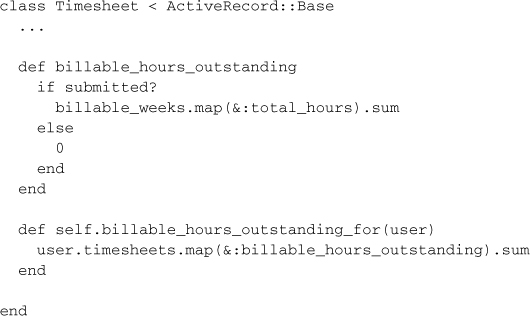
I’m not suggesting that this is good code. It works, but it’s inefficient and that if/else condition is a little fishy. Its shortcomings become apparent once requirements emerge about marking a Timesheet as paid. It forces us to modify Timesheet’s billable_hours_outstanding method again:
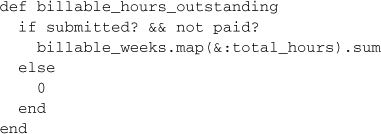
That latest change is a clear violation of the open-closed principle,6 which urges you to write code that is open for extension, but closed for modification. We know that we violated the principle, because we were forced to change the billable_hours_outstanding method to accommodate the new Timesheet status. Though it may not seem like a large problem in our simple example, consider the amount of conditional code that will end up in the Timesheet class once we start having to implement functionality such as paid_hours and unsubmitted_hours.
So what’s the answer to this messy question of the constantly changing conditional? Given that you’re reading the section of the book about single-table inheritance, it’s probably no big surprise that we think one good answer is to use object-oriented inheritance. To do so, let’s break our original Timesheet class into four classes.
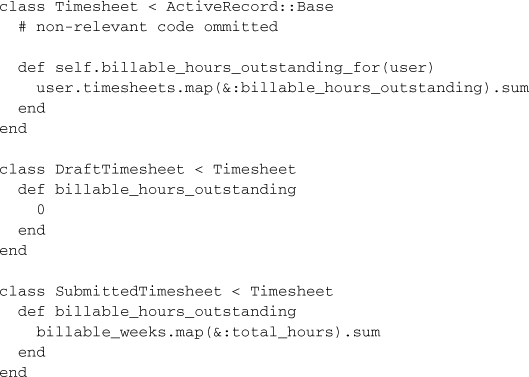
Now when the requirements demand the ability to calculate partially paid timesheets, we need only add some behavior to a PaidTimesheet class. No messy conditional statements in sight!

9.5.1 Mapping Inheritance to the Database
Mapping object inheritance effectively to a relational database is not one of those problems with a definitive solution. We’re only going to talk about the one mapping strategy that Rails supports natively, which is single-table inheritance, called STI for short.
In STI, you establish one table in the database to holds all of the records for any object in a given inheritance hierarchy. In Active Record STI, that one table is named after the top parent class of the hierarchy. In the example we’ve been considering, that table would be named timesheets.
Hey, that’s what it was called before, right? Yes, but to enable STI we have to add a type column to contain a string representing the type of the stored object. The following migration would properly set up the database for our example:

No default value is needed. Once the type column is added to an Active Record model, Rails will automatically take care of keeping it populated with the right value. Using the console, we can see this behavior in action:
>> d = DraftTimesheet.create
>> d.type
=> 'DraftTimesheet'
When you try to find an object using the find methods of a base STI class, Rails will automatically instantiate objects using the appropriate subclass. This is especially useful in polymorphic situations, such as the timesheet example we’ve been describing, where we retrieve all the records for a particular user and then call methods that behave differently depending on the object’s class.
>> Timesheet.find(:first)
=> #<DraftTimesheet:0x2212354...>
Sebastian says ...
The word “type” is a very common column name and you might have plenty of uses for it not related to STI—which is why it’s very likely you’ve experienced an ActiveRecord::SubclassNotFound error. Rails will read the “type” column of your Car class and try to find an “SUV” class that doesn’t exist. The solution is simple: Tell Rails to use another column for STI with the following code:
set_inheritance_column "not_sti"
Note
Rails won’t complain about the missing column; it will simply ignore it. Recently, the error message was reworded with a better explanation, but too many developers skim error messages and then spend an hour trying to figure out what’s wrong with their models. (A lot of people skim sidebar columns too when reading books, but hey, at least I am doubling their chances of learning about this problem.)
9.5.2 STI Considerations
Although Rails makes it extremely simple to use single-table inheritance, there are a few caveats that you should keep in mind.
To begin with, you cannot have an attribute on two different subclasses with the same name but a different type. Since Rails uses one table to store all subclasses, these attributes with the same name occupy the same column in the table. Frankly, there’s not much of a reason why that should be a problem unless you’ve made some pretty bad data-modeling decisions.
More importantly, you need to have one column per attribute on any subclass and any attribute that is not shared by all the subclasses must accept nil values. In the recurring example, PaidTimesheet has a paid_hours column that is not used by any of the other subclasses. DraftTimesheet and SubmittedTimesheet will not use the paid_hours column and leave it as null in the database. In order to validate data for columns not shared by all subclasses, you must use Active Record validations and not the database.
Third, it is not a good idea to have subclasses with too many unique attributes. If you do, you will have one database table with many null values in it. Normally, a tree of subclasses with a large number of unique attributes suggests that something is wrong with your application design and that you should refactor. If you have an STI table that is getting out of hand, it is time to reconsider your decision to use inheritance to solve your particular problem. Perhaps your base class is too abstract?
Finally, legacy database constraints may require a different name in the database for the type column. In this case, you can set the new column name using the class method set_inheritance_column in the base class. For the Timesheet example, we could do the following:
class Timesheet < ActiveRecord::Base
set_inheritance_column 'object_type'
end
Now Rails will automatically populate the object_type column with the object’s type.
9.5.3 STI and Associations
It seems pretty common for applications, particularly data-management ones, to have models that are very similar in terms of their data payload, mostly varying in their behavior and associations to each other. If you used object-oriented languages prior to Rails, you’re probably already accustomed to breaking down problem domains into hierarchical structures.
Take for instance, a Rails application that deals with the population of states, counties, cities, and neighborhoods. All of these are places, which might lead you to define an STI class named Place as shown in Listing 9.2. I’ve also included the database schema for clarity:7
Listing 9.2. The places database schema and the place class
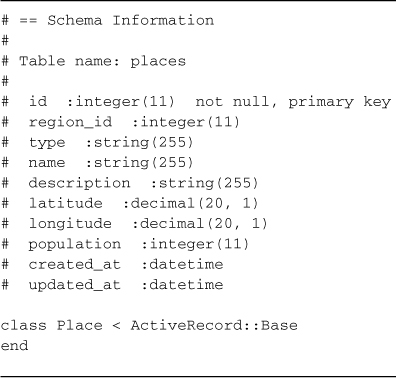
Place is in essence an abstract class. It should not be instantiated, but there is no foolproof way to enforce that in Ruby. (No big deal, this isn’t Java!) Now let’s go ahead and define concrete subclasses of Place:
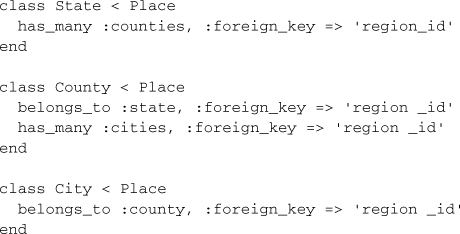
You might be tempted to try adding a cities association to State, knowing that has_many :through works with both belongs_to and has_many target associations. It would make the State class look something like this:

That would certainly be cool, if it worked. Unfortunately, in this particular case, since there’s only one underlying table that we’re querying, there simply isn’t a way to distinguish among the different kinds of objects in the query:

What would we have to do to make it work? Well, the most realistic would be to use specific foreign keys, instead of trying to overload the meaning of region_id for all the subclasses. For starters, the places table would look like the example in Listing 9.3.
Listing 9.3. The places database schema revised

The subclasses would be simpler without the :foreign_key options on the associations. Plus you could use a regular has_many relationship from State to City, instead of the more complicated has_many :through.
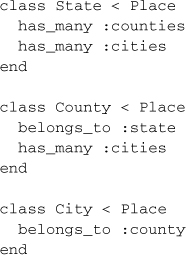
Of course, all those null columns in the places table won’t win you any friends with relational database purists. That’s nothing, though. Just a little bit later in this chapter we’ll take a second, more in-depth look at polymorphic has_many relationships, which will make the purists positively hate you.
9.6 Abstract Base Model Classes
In contrast to single-table inheritance, it is possible for Active Record models to share common code via inheritance and still be persisted to different database tables. In fact, every Rails developer uses an abstract model in their code whether they realize it or not: ActiveRecord::Base.8
The technique involves creating an abstract base model class that persistent subclasses will extend. It’s actually one of the simpler techniques that we broach in this chapter. Let’s take the Place class from the previous section (refer to Listing 9.3) and revise it to be an abstract base class in Listing 9.4. It’s simple really—we just have to add one line of code:
Listing 9.4. The abstract place class

Marking an Active Record model abstract is essentially the opposite of making it an STI class with a type column. You’re telling Rails: “Hey, I don’t want you to assume that there is a table named places.”
In our running example, it means we would have to establish tables for states, counties, and cities, which might be exactly what we want. Remember though, that we would no longer be able to query across subtypes with code like Place.all.
Abstract classes is an area of Rails where there aren’t too many hard-and-fast rules to guide you—experience and gut feeling will help you out.
In case you haven’t noticed yet, both class and instance methods are shared down the inheritance hierarchy of Active Record models. So are constants and other class members brought in through module inclusion. That means we can put all sorts of code inside Place that will be useful to its subclasses.
9.7 Polymorphic has_many Relationships
Rails gives you the ability to make one class belong_to more than one type of another class, as eloquently stated by blogger Mike Bayer:
The “polymorphic association,” on the other hand, while it bears some resemblance to the regular polymorphic union of a class hierarchy, is not really the same since you’re only dealing with a particular association to a single target class from any number of source classes, source classes which don’t have anything else to do with each other; i.e., they aren’t in any particular inheritance relationship and probably are all persisted in completely different tables. In this way, the polymorphic association has a lot less to do with object inheritance and a lot more to do with aspect-oriented programming (AOP); a particular concept needs to be applied to a divergent set of entities which otherwise are not directly related. Such a concept is referred to as a cross-cutting concern, such as, all the entities in your domain need to support a history log of all changes to a common logging table. In the AR example, an Order and a User object are illustrated to both require links to an Address object.9
In other words, this is not polymorphism in the typical object-oriented sense of the word; rather, it is something unique to Rails.
9.7.1 In the Case of Models with Comments
In our recurring Time and Expenses example, let’s assume that we want both BillableWeek and Timesheet to have many comments (a shared Comment class). A naive way to solve this problem might be to have the Comment class belong to both the BillableWeek and Timesheet classes and have billable_week_id and timesheet_id as columns in its database table.

I call that approach is naive because it would be difficult to work with and hard to extend. Among other things, you would need to add code to the application to ensure that a Comment never belonged to both a BillableWeek and a Timesheet at the same time. The code to figure out what a given comment is attached to would be cumbersome to write. Even worse, every time you want to be able to add comments to another type of class, you’d have to add another nullable foreign key column to the comments table.
Rails solves this problem in an elegant fashion, by allowing us to define what it terms polymorphic associations, which we covered when we described the :polymorphic => true option of the belongs_to association in Chapter 7, Active Record Associations.
The Interface
Using a polymorphic association, we need define only a single belongs_to and add a pair of related columns to the underlying database table. From that moment on, any class in our system can have comments attached to it (which would make it commentable), without needing to alter the database schema or the Comment model itself.

There isn’t a Commentable class (or module) in our application. We named the association :commentable because it accurately describes the interface of objects that will be associated in this way. The name :commentable will turn up again on the other side of the association:
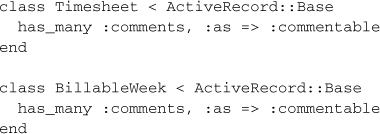
Here we have the friendly has_many association using the :as option. The :as marks this association as polymorphic, and specifies which interface we are using on the other side of the association. While we’re on the subject, the other end of a polymorphic belongs_to can be either a has_many or a has_one and work identically.
The Database Columns
Here’s a migration that will create the comments table:
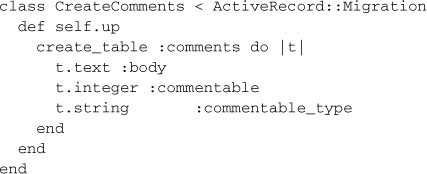
As you can see, there is a column called commentable_type, which stores the class name of associated object. The Migrations API actually gives you a one-line shortcut with the references method, which takes a polymorphic option:

We can see how it comes together using the Rails console (some lines ommitted for brevity):
As you can tell, both the Timesheet and the BillableWeek that we played with in the console had the same id (1). Thanks to the commentable_type attribute, stored as a string, Rails can figure out which is the correct related object.
has_many :through and Polymorphics
There are some logical limitations that come into play with polymorphic associations. For instance, since it is impossible for Rails to know the tables necessary to join through a polymorphic association, the following hypothetical code, which tries to find everything that the user has commented on, will not work.

If you really need it, has_many :through is possible with polymorphic associations, but only by specifying exactly what type of polymorphic associations you want. To do so, you must use the :source_type option. In most cases, you will also need to use the :source option, since the association name will not match the interface name used for the polymorphic association:

It’s verbose, and the whole scheme loses its elegance if you go this route, but it works:
>> User.first.commented_timesheets
=> [#<Timesheet ...>]
9.8 Foreign-key Constraints
As we work toward the end of this book’s coverage of Active Record, you might have noticed that we haven’t really touched on a subject of particular importance to many programmers: foreign-key constraints in the database. That’s mainly because use of foreign-key constraints simply isn’t the Rails way to tackle the problem of relational integrity. To put it mildly, that opinion is controversial and some developers have written off Rails (and its authors) for expressing it.
There really isn’t anything stopping you from adding foreign-key constraints to your database tables, although you’d do well to wait until after the bulk of development is done. The exception, of course, is those polymorphic associations, which are probably the most extreme manifestation of the Rails opinion against foreign-key constraints. Unless you’re armed for battle, you might not want to broach that particular subject with your DBA.
9.9 Using Value Objects
In Domain Driven Design10 (DDD), a distinction is drawn between Entity Objects and Value Objects. All model objects that inherit from ActiveRecord::Base could be considered Entity Objects in DDD. An Entity object cares about identity, since each one is unique. In Active Record uniqueness is derived from the primary key. Comparing two different Entity Objects for equality should always return false, even if all of its attributes (other than the primary key) are equivalent.
Here is an example comparing two Active Record Addresses:

In this case you are actually creating two new Address records and persisting them to the database, therefore they have different primary key values.
Value Objects on the other hand only care that all their attributes are equal. When creating Value Objects for use with Active Record you do not inherit from ActiveRecord::Base. Instead you make them part of a parent model using the composed_of class method. This is a form of composition, called an Aggregate in DDD. The attributes of the Value Object are stored in the database together with the parent object and composed_of provides a means to interact with those values as a single object.
A simple example is of a Person with a single Address. To model this using composition, first we need a Person model with fields for the Address. Create it with the following migration:

The Person model looks like this:

We’d need a corresponding Address object which looks like this:
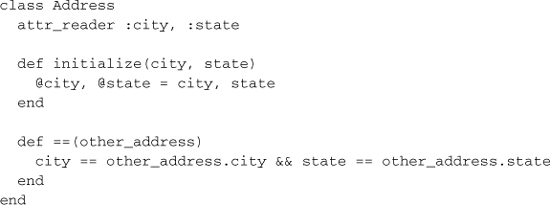
Note that this is just a standard Ruby object that does not inherit from ActiveRecord::Base. We have defined reader methods for our attributes and are assigning them upon initialization. We also have to define our own == method for use in comparisons. Wrapping this all up we get the following usage:

Alternately you can instantiate the address directly and assign it using the address accessor:

9.9.1 Immutability
It’s also important to treat value objects as immutable. Don’t allow them to be changed after creation. Instead, create a new object instance with the new value instead. Active Record will not persist value objects that have been changed through means other than the writer method.
The immutable requirement is enforced by Active Record by freezing any object assigned as a value object. Attempting to change it afterwards will result in a ActiveSupport::FrozenObjectError.
9.9.2 Custom Constructors and Converters
By default value objects are initialized by calling the new constructor of the value class with each of the mapped attributes, in the order specified by the :mapping option, as arguments. If for some reason your value class does not work well with that convention, composed_of allows a custom constructor to be specified.
When a new value object is assigned to its parent, the default assumption is that the new value is an instance of the value class. Specifying a custom converter allows the new value to be automatically converted to an instance of value class (when needed).
For example, consider the NetworkResource model with network_address and cidr_range attributes that should be contained in a NetAddr::CIDR value class.11 The constructor for the value class is called create and it expects a CIDR address string as a parameter. New values can be assigned to the value object using either another NetAddr::CIDR object, a string or an array. The :constructor and :converter options are used to meet the requirements:
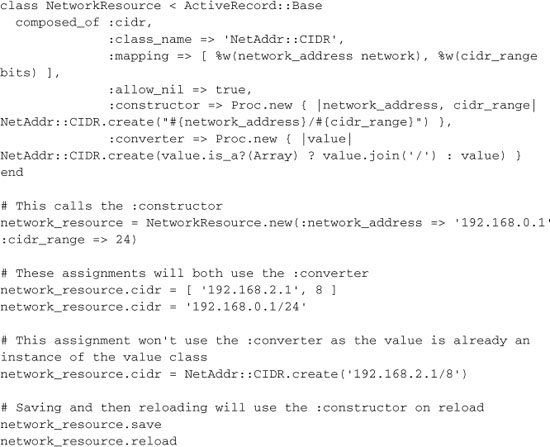
9.9.3 Finding Records by a Value Object
Once a composed_of relationship is specified for a model, records can be loaded from the database by specifying an instance of the value object in the conditions hash. The following example finds all customers with balance_amount equal to 20 and balance_currency equal to "USD":
Customer.where(:balance => Money.new(20, "USD"))
The Money Gem
A common approach to using composed_of is in conjunction with the money gem.12

Remember to add a migration with the 2 columns, the integer cents and the string currency that money needs.
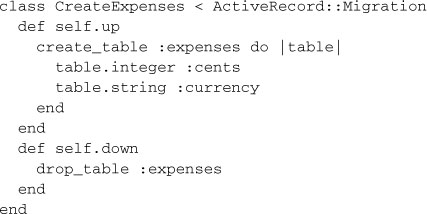
Now when asking for or setting the cost of an item would use a Money instance.

9.10 Modules for Reusing Common Behavior
In this section, we’ll talk about one strategy for breaking out functionality that is shared between disparate model classes. Instead of using inheritance, we’ll put the shared code into modules.
In the section “Polymorphic has_many Relationships,” we described how to add a commenting feature to our recurring sample Time and Expenses application. We’ll continue fleshing out that example, since it lends itself to factoring out into modules.
The requirements we’ll implement are as follows: Both users and approvers should be able to add their comments to a Timesheet or ExpenseReport. Also, since comments are indicators that a timesheet or expense report requires extra scrutiny or processing time, administrators of the application should be able to easily view a list of recent comments. Human nature being what it is, administrators occasionally gloss over the comments without actually reading them, so the requirements specify that a mechanism should be provided for marking comments as “OK” first by the approver, then by the administrator.
Again, here is the polymorphic has_many :comments, :as => :commentable that we used as the foundation for this functionality:
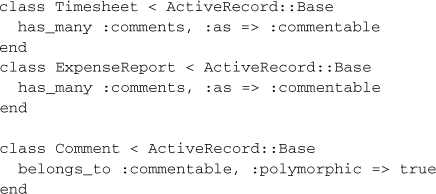
Next we enable the controller and action for the administrator that list the 10 most recent comments with links to the item to which they are attached.

Here’s some of the simple view template used to display the recent comments.

So far, so good. The polymorphic association makes it easy to access all types of comments in one listing. In order to find all of the unreviewed comments for an item, we can use a named scope on the Comment class together with the comments association.

Both Timesheet and ExpenseReport currently have identical has_many methods for comments. Essentially, they both share a common interface. They’re commentable!
To minimize duplication, we could specify common interfaces that share code in Ruby by including a module in each of those classes, where the module contains the code common to all implementations of the common interface. So, mostly for the sake of example, let’s go ahead and define a Commentable module to do just that, and include it in our model classes:
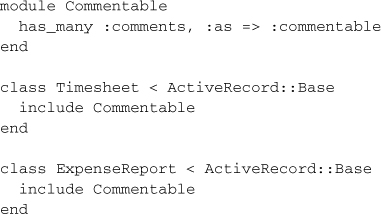
Whoops, this code doesn’t work! To fix it, we need to understand an essential aspect of the way that Ruby interprets our code dealing with open classes.
9.10.1 A Review of Class Scope and Contexts
In many other interpreted OO programming languages, you have two phases of execution—one in which the interpreter loads the class definitions and says “this is the definition of what I have to work with,” followed by the phase in which it executes the code. This makes it difficult (though not necessarily impossible) to add new methods to a class dynamically during execution.
In contrast, Ruby lets you add methods to a class at any time. In Ruby, when you type class MyClass, you’re doing more than simply telling the interpreter to define a class; you’re telling it to “execute the following code in the scope of this class.”
Let’s say you have the following Ruby script:
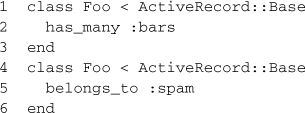
When the interpreter gets to line 1, you are telling it to execute the following code (up to the matching end) in the context of the Foo class object. Because the Foo class object doesn’t exist yet, it goes ahead and creates the class. At line 2, we execute the statement has_many :bars in the context of the Foo class object. Whatever the has_many method does, it does right now.
When we again say class Foo at line 4, we are once again telling the interpreter to execute the following code in the context of the Foo class object, but this time, the interpreter already knows about class Foo; it doesn’t actually create another class. Therefore, on line 5, we are simply telling the interpreter to execute the belongs_to :spam statement in the context of that same Foo class object.
In order to execute the has_many and belongs_to statements, those methods need to exist in the context in which they are executed. Because these are defined as class methods in ActiveRecord::Base, and we have previously defined class Foo as extending ActiveRecord::Base, the code will execute without a problem.
However, when we defined our Commentable module like this:
module Commentable
has_many :comments, :as => :commentable
end
...we get an error when it tries to execute the has_many statement. That’s because the has_many method is not defined in the context of the Commentable module object.
Given what we now know about how Ruby is interpreting the code, we now realize that what we really want is for that has_many statement to be executed in the context of the including class.
9.10.2 The included Callback
Luckily, Ruby’s Module class defines a handy callback that we can use to do just that. If a Module object defines the method included, it gets run whenever that module is included in another module or class. The argument passed to this method is the module/class object into which this module is being included.
We can define an included method on our Commentable module object so that it executes the has_many statement in the context of the including class (Timesheet, ExpenseReport, and so on):

Now, when we include the Commentable module in our model classes, it will execute the has_many statement just as if we had typed it into each of those classes’ bodies.
The technique is common enough, within Rails and plugins, that it was added as a first-class concept in the Rails 3 ActiveSupport API. The above example becomes shorter and easier to read as a result:

Whatever is inside of the included block will get executed in the class context of the class where the module is included.
has_many :comments, :as => :commentable, :extend => Commentable
Courtenay says ...
There’s a fine balance to strike here. Magic like include Commentable certainly saves on typing and makes your model look less complex, but it can also mean that your association code is doing things you don’t know about. This can lead to confusion and hours of head-scratching while you track down code in a separate module. My personal preference is to leave all associations in the model, and extend them with a module. That way you can quickly get a list of all associations just by looking at the code.
9.11 Modifying Active Record Classes at Runtime
The metaprogramming capabilities of Ruby, combined with the after_find callback, open the door to some interesting possibilities, especially if you’re willing to blur your perception of the difference between code and data. I’m talking about modifying the behavior of model classes on the fly, as they’re loaded into your application.
Listing 9.5 is a drastically simplified example of the technique, which assumes the presence of a config column on your model. During the after_find callback, we get a handle to the unique singleton class13 of the model instance being loaded. Then we execute the contents of the config attribute belonging to this particular Account instance, using Ruby’s class_eval method. Since we’re doing this using the singleton class for this instance, rather than the global Account class, other account instances in the system are completely unaffected.
Listing 9.5. Runtime metaprogramming with after_find
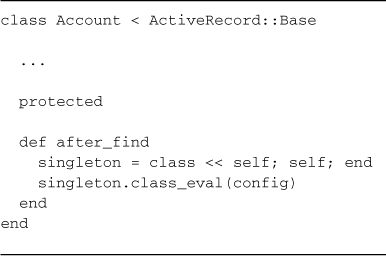
I used powerful techniques like this one in a supply-chain application that I wrote for a large industrial client. A lot is a generic term in the industry used to describe a shipment of product. Depending on the vendor and product involved, the attributes and business logic for a given lot vary quite a bit. Since the set of vendors and products being handled changed on a weekly (sometimes daily) basis, the system needed to be reconfigurable without requiring a production deployment.
Without getting into too much detail, the application allowed the maintenance programmers to easily customize the behavior of the system by manipulating Ruby code stored in the database, associated with whatever product the lot contained.
For example, one of the business rules associated with lots of butter being shipped for Acme Dairy Co. might dictate a strictly integral product code, exactly 10 digits in length. The code, stored in the database, associated with the product entry for Acme Dairy’s butter product would therefore contain the following two lines:
![]()
9.11.1 Considerations
A relatively complete description of everything you can do with Ruby metaprogramming, and how to do it correctly, would fill its own book. For instance, you might realize that doing things like executing arbitrary Ruby code straight out of the database is inherently dangerous. That’s why I emphasize again that the examples shown here are very simplified. All I want to do is give you a taste of the possibilities.
If you do decide to begin leveraging these kinds of techniques in real-world applications, you’ll have to consider security and approval workflow and a host of other important concerns. Instead of allowing arbitrary Ruby code to be executed, you might feel compelled to limit it to a small subset related to the problem at hand. You might design a compact API, or even delve into authoring a domain-specific language (DSL), crafted specifically for expressing the business rules and behaviors that should be loaded dynamically. Proceeding down the rabbit hole, you might write custom parsers for your DSL that could execute it in different contexts—some for error detection and others for reporting. It’s one of those areas where the possibilities are quite limitless.
9.11.2 Ruby and Domain-Specific Languages
My former colleague Jay Fields and I pioneered the mix of Ruby metaprogramming, Rails, and internal14 domain-specific languages while doing Rails application development for clients. I still occasionally speak at conferences and blog about writing DSLs in Ruby.
Jay has also written and delivered talks about his evolution of Ruby DSL techniques, which he calls Business Natural Languages (or BNL for short15). When developing BNLs, you craft a domain-specific language that is not necessarily valid Ruby syntax, but is close enough to be transformed easily into Ruby and executed at runtime, as shown in Listing 9.6.
Listing 9.6. Example of business natural language
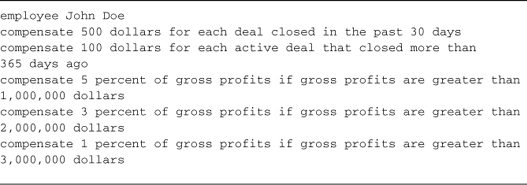
The ability to leverage advanced techniques such as DSLs is yet another powerful tool in the hands of experienced Rails developers.
9.12 Conclusion
With this chapter we conclude our coverage of Active Record. Among other things, we examined how callbacks and observers let us factor our code in a clean and object-oriented fashion. We also expanded our modeling options by considering single-table inheritance, abstract classes and Active Record’s distinctive polymorphic relationships.
At this point in the book, we’ve covered two parts of the MVC pattern: the model and the controller. It’s now time to delve into the third and final part: the view.
Courtenay says ...
DSLs suck! Except the ones written by Obie, of course. The only people who can read and write most DSLs are their original authors. As a developer taking over a project, it’s often quicker to just reimplement instead of learning the quirks and exactly which words you’re allowed to use in an existing DSL. In fact, a lot of Ruby metaprogramming sucks, too. It’s common for people gifted with these new tools to go a bit overboard. I consider metaprogramming, self.included, class_eval, and friends to be a bit of a code smell on most projects. If you’re making a web application, future developers and maintainers of the project will appreciate your using simple, direct, granular, and well-tested methods, rather than monkeypatching into existing classes, or hiding associations in modules. That said, if you can pull it off... your code will become more powerful than you can possibly imagine.



